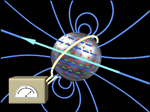WEEKLY HIGHLIGHTS FOR 17 SEPTEMBER 2004:
GRAVITY PROBE B MISSION UPDATE
After 21 weeks in orbit, GP-B finally has all four gyroscopes generating relativity data. Gyro #4 joined Gyro’s #1, #2, and #3 in science mode this week after its spin axis was successfully aligned with the guide star, IM Pegasi, on Tuesday. The official transition occurred on Thursday morning (PDT), marking the first time that GP-B is conducting science on all four gyros.
The spacecraft continues to be in excellent health, rolling at a rate of 0.7742 rpm (one revolution every 77.5 seconds). The Attitude and Translation Control (ATC) system is maintaining a drag-free orbit around gyro #3, and it is properly tracking the guide star, IM Pegasi. The Dewar temperature is nominal (1.82 Kelvin), and the flow of helium, venting from the Dewar through the micro thrusters has remained within expected limits.
During the week, GP-B continued to tune-up the ATC system by improving the quality of “roll phase data” of the spacecraft. This data increases the precision with which we can monitor the alignment of the gyroscopes. The “roll phase data” refers to the precise orientation of the spacecraft as it rolls around its axis (360 degrees every 77.5 seconds).

When the spacecraft rolls, so do the pickup loops encircling each gyroscope. These superconducting wire loops are used to monitor the orientation of the magnetic field around each gyroscope. They are located in the same plane as the spacecraft’s roll axis, so when the spacecraft rolls the loops turn with it. As a result, the loops perceive a “change” in each gyroscope’s orientation as the wire turns through the gyroscope’s magnetic field.
If GP-B knows the exact orientation of the spacecraft (and, in turn, the pickup loops) at each moment in time, we can better determine the orientation of each gyroscope. The spacecraft’s orientation is determined primarily through the two star trackers located on the forward portion of the spacecraft on opposite sides. These star trackers image the starry sky through an 8� In last week’s highlights, we noted that a double-bit error in computer memory was caused by “a proton hit”. An astute reader asked, “How do we know that the spacecraft was hit by proton?” Onboard the spacecraft is a proton detector, specially made for the GP-B mission. Its purpose is to monitor the high-energy particles that impact the spacecraft and the science instrument. This proton flux can lead to the accumulation of charge on the gyroscopes, which in turn could lead to unacceptable torques on the gyroscopes. So far, the charge accumulated on the gyroscopes is much less than expected. One ancillary benefit of GP-B’s proton monitor has been its ability to accurately locate the South Atlantic Anomaly, a region above the South Atlantic Ocean where the fluxes of particles trapped in the Earth’s geomagnetic field are much greater than anywhere else. GP-B’s orbit takes it through this region regularly, allowing it to produce a more precise map of this magnetic anomaly. Drawings: The images of the GP-B science instrument and the South Atlantic Anomaly are from the GP-B Image Archives here at Stanford. Click on the thumbnails to view these diagrams at full size. Please Note: We will continue updating these highlights and
sending out the GP-B email update on a weekly basis through the first few weeks
of the Science
Phase of the mission. Then,
as mission operations become
routine, we may reduce the frequency these updates to biweekly. However, from
time to time, we intend to post special reports and special updates, as warranted
by mission events.
To the right, is a thumbnail of a photograph of the GP-B spacecraft in
orbit, along with the guide star, IM Pegasi. (Click on the thumbnail to view
the photo at full size.) The photo was taken and emailed to us
by Stefano
Sposetti, a Swiss physics teacher and amateur astronomer. Stefano used a 40cm
newtonian telescope, with a CCD camera and 20mm wide field lens attached to
make this photo. He then sent us the two versions shown — the normal (black
sky) version on the right, and an inverse
version in which the constellation, Pegasus, the guide star IM Pegasi, and
the path
of the GP-B spacecraft are highlighted for easy identification on the left. We are grateful
to Stefano for sending us this wonderful photo. You can view other astronomical
photos that he has taken on his Web page: http://aida.astronomie.info/sposetti.
Following is Stefano's description of his photo: In this picture one can see the quite dim GP-B satellite traveling from North
(up) to South (down) direction. The bold line in the right part of the left
image represents the satellite trail just before entering the earth shadow.
(Every satellite becomes visible because it reflects the sunlight). The connecting
lines show the constellation Pegasus. The small circle around the star is IM
Pegasi, the guide star used by the spacecraft's telescope in his experiment!
GP-B is a circumpolar satellite following a free fall trajectory about 640km
above
the earth surface. From my location the satellite passed that night at
a maximum elevation of 87degrees, thus not exactly overhead. The brightness
of the satellite was between 3mag and 4mag. The Moon, about in the last quarter
phase, illuminated the sky and was a drawback for having a good signal/noise
ratio of the satellite trace. I took this 60-seconds black and white CCD picture
with a 20mm,f/2.8 lens on august 6 centered at 01:19:00 UT. North is up, East
is left.
SWISS AMATEUR ASTRONOMER PHOTOGRAPHS GP-B GP-B SPACECRAFT IN ORBIT WITH GUIDE
STAR IM PEGASI

More links on recent topics
